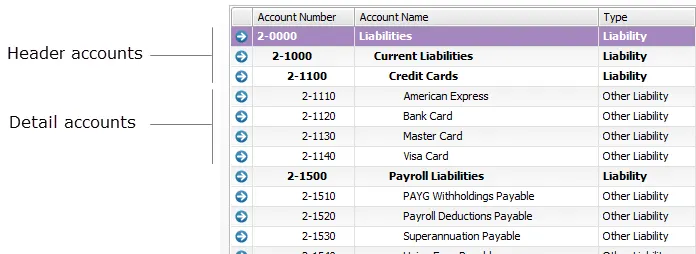Accounts provide a means for grouping similar transactions. For example, if your business pays rent for the use of its premises, you would create a rent expense account and then allocate all rent payments to that account.
Take a look at this quick overview of accounts:
Accessing your accounts list
You can see all accounts that are already set up for you by going to the Accounts command centre and clicking Accounts List.
When you created your company file, you selected a default accounts list to start with. This list may already have the accounts you need. If not, learn how to create detail and header accounts, import a list of accounts and delete accounts.
If you're unsure, ask your accountant which accounts you should create, edit or delete (you can invite them to access your file online - see Invite a user to an online file).
To see a sample accounts list and to try out features before you add your own data, open AccountRight's sample company file, Clearwater.
Account numbers
Each account is identified by a unique five-digit number. The first digit indicates the account’s classification (for example, accounts starting with 1 are asset accounts). The remaining four digits determine its location within the classification. The lower the number, the higher up in the list it appears. For example, account 1-1100 appears above 1-1200.
Select accounts by name or number – If you'd prefer to select accounts in transaction windows by typing the account name instead of the number, turn on this preference: Setup menu > Preferences > Windows tab > Select and Display Account Name, Not Account Number.
Account classifications and types
The accounts list groups accounts into eight classifications—Asset, Liability, Equity, Income, Cost of Sales, Expense, Other Income and Other Expense. Within each account classification there is at least one account type.
Account classifications and types are described in the following tables.
Types of asset (1-xxxx)
Type | Description |
|---|---|
Bank | Money in the bank, for example, in a cheque or savings account. |
Accounts Receivable | Money owed to you by your customers. |
Other Current Assets | Assets that, if required, can be turned into cash within a year. These may include your term deposits. |
Fixed Asset | Assets which have a long life, for example, buildings, cars and computers. Fixed assets are usually depreciated. |
Other Asset | Other assets you own such as loans made to others and goodwill. |
Types of liability (2-xxxx)
Type | Description |
|---|---|
Credit Card | Repayments required to service credit card debt. |
Accounts Payable | Money owed by you to your suppliers. |
Other Current Liability | Money owed by you that is due in less than a year, for example, GST. |
Long Term Liability | Money owed by you that is due in more than one year, for example, a business loan. |
Other Liability | Other money you owe. |
Other types and classifications
Classification | Type | Description |
|---|---|---|
Equity | Equity | The business’s net worth, that is, its assets minus its liabilities. Common equity accounts are current year earnings, retained earnings and shareholders’ equity. |
Income | Income | Revenue from the sale of goods and services. |
Cost of Sales | Cost of Sales | The direct cost of selling your goods and providing services, for example, purchase costs and freight charges. |
Expense | Expense | The day-to-day expenses of running your business, for example, utility bills, employee wages and cleaning. |
Other Income | Other Income | Other revenues, for example, interest earned on savings and dividends paid from shares. |
Other Expense | Other Expense | Other expenses, for example, interest charged. |
Header and detail accounts
Your accounts list consists of:
detail accounts—sometimes called sub-accounts, these are the accounts to which you allocate transactions.
header accounts—these accounts group related detail accounts to help you organise your accounts list.
For example, you could group your telephone, electricity and gas expense accounts using a Utilities header account. This makes it easier for you to locate the utility expense accounts in the accounts list and to see your combined utility expenses.
You group accounts by indenting the detail accounts located directly below a header account. For more information, see Create detail and header accounts.

Note that:
You cannot allocate transactions to a header account.
The balance of a header account is the sum of the detail accounts indented directly below it.
You can have up to three header account levels.
How you group your accounts can affect how totals and subtotals are calculated on reports.
Top level header accounts, such as 2-0000, cannot be edited.